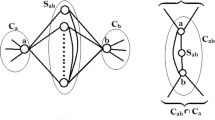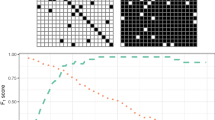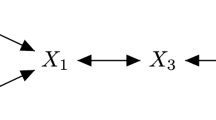Abstract
Conditional correlation networks, within Gaussian Graphical Models (GGM), are widely used to describe the direct interactions between the components of a random vector. In the case of an unlabelled Heterogeneous population, Expectation Maximisation (EM) algorithms for Mixtures of GGM have been proposed to estimate both each sub-population’s graph and the class labels. However, we argue that, with most real data, class affiliation cannot be described with a Mixture of Gaussian, which mostly groups data points according to their geometrical proximity. In particular, there often exists external co-features whose values affect the features’ average value, scattering across the feature space data points belonging to the same sub-population. Additionally, if the co-features’ effect on the features is Heterogeneous, then the estimation of this effect cannot be separated from the sub-population identification. In this article, we propose a Mixture of Conditional GGM (CGGM) that subtracts the heterogeneous effects of the co-features to regroup the data points into sub-population corresponding clusters. We develop a penalised EM algorithm to estimate graph-sparse model parameters. We demonstrate on synthetic and real data how this method fulfils its goal and succeeds in identifying the sub-populations where the Mixtures of GGM are disrupted by the effect of the co-features.










Similar content being viewed by others
References
Akaike H. A new look at the statistical model identification. IEEE Trans Autom Control. 1974;19(6):716–23.
Banerjee O, Ghaoui LE, d’Aspremont A, Natsoulis G. Convex optimization techniques for fitting sparse gaussian graphical models. In: Proceedings of the 23rd international conference on Machine learning, ACM, 2006;89–96.
Banerjee O, Ghaoui LE, d’Aspremont A. Model selection through sparse maximum likelihood estimation for multivariate gaussian or binary data. J Mach Learning Res. 2008;9:485–516.
Chun H, Chen M, Li B, Zhao H. Joint conditional gaussian graphical models with multiple sources of genomic data. Front Genet. 2013;4:294.
Combettes PL, Pesquet JC. Proximal splitting methods in signal processing. In: Fixed-point algorithms for inverse problems in science and engineering, Springer, 2011; 185–212.
Danaher P, Wang P, Witten DM. The joint graphical lasso for inverse covariance estimation across multiple classes. J Royal Stat Soc Series B. 2014;76(2):373–97.
Dempster AP. Covariance selection. Biometrics 1972; 157–175.
DeSarbo WS, Cron WL. A maximum likelihood methodology for clusterwise linear regression. J Classif. 1988;5(2):249–82.
Figueiredo MAT, Jain AK. Unsupervised learning of finite mixture models. IEEE Trans Pattern Anal Mach Intell. 2002;24(3):381–96.
Fop M, Murphy TB, Scrucca L. Model-based clustering with sparse covariance matrices. Stat Comput. 2019;29(4):791–819.
Friedman J, Hastie T, Tibshirani R. Sparse inverse covariance estimation with the graphical lasso. Biostatistics. 2008;9(3):432–41.
Gao C, Zhu Y, Shen X, Pan W. Estimation of multiple networks in gaussian mixture models. Electron J Stat. 2016;10:1133.
Guo J, Levina E, Michailidis G, Zhu J. Joint estimation of multiple graphical models. Biometrika. 2011;98(1):1–15.
Hao B, Sun WW, Liu Y, Cheng G. Simultaneous clustering and estimation of heterogeneous graphical models. J Mach Learning Res. 2017;18(1):7981–8038.
Hara Y, Suzuki J, Kuwahara M. Network-wide traffic state estimation using a mixture gaussian graphical model and graphical lasso. Transport Res Part C Emerging Technol. 2018;86:622–38.
Honorio J, Samaras D. Multi-task learning of gaussian graphical models. In: ICML, Citeseer, 2010; 447–454.
Huang F, Chen S, Huang SJ. Joint estimation of multiple conditional Gaussian graphical models. IEEE Trans Neural Netw Learning Syst. 2018;29(7):3034–46.
Hurvich CM, Tsai CL. Regression and time series model selection in small samples. Biometrika. 1989;76(2):297–307.
Jordan MI, Jacobs RA. Hierarchical mixtures of experts and the EM algorithm. Neural Comput. 1994;6(2):181–214.
Khalili A, Chen J. Variable selection in finite mixture of regression models. J Am Stat Assoc. 2007;102(479):1025–38.
Kim M. Sparse inverse covariance learning of conditional Gaussian mixtures for multiple-output regression. Appl Intell. 2016;44(1):17–29.
Krishnamurthy A. High-dimensional clustering with sparse gaussian mixture models. Unpublished paper 2011; 191–192.
Kullback S, Leibler RA. On information and sufficiency. Ann Math Stat. 1951;22(1):79–86.
Lartigue T. Mixture of gaussian graphical models with constraints. PhD thesis, Institut Polytechnique de Paris 2020.
Lee H, Ghosh SK. Performance of information criteria for spatial models. J Stat Comput Simul. 2009;79(1):93–106.
Mohan K, London P, Fazel M, Witten D, Lee SI. Node-based learning of multiple Gaussian graphical models. J Mach Learning Res. 2014;15(1):445–88.
Ou-Yang L, Zhang XF, Hu X, Yan H. Differential network analysis via weighted fused conditional gaussian graphical model. IEEE/ACM transactions on computational biology and bioinformatics 2019.
Schiratti JB, Allassonniere S, Routier A, Colliot O, Durrleman S, Initiative ADN, et al. A mixed-effects model with time reparametrization for longitudinal univariate manifold-valued data. In: International Conference on Information Processing in Medical Imaging, Springer, 2015; 564–575.
Schwarz G, et al. Estimating the dimension of a model. Ann Stat. 1978;6(2):461–4.
Sohn KA, Kim S. Joint estimation of structured sparsity and output structure in multiple-output regression via inverse-covariance regularization. In: Artificial Intelligence and Statistics, 2012; 1081–1089.
Varoquaux G, Gramfort A, Poline JB, Thirion B. Brain covariance selection: better individual functional connectivity models using population prior. In: Advances in neural information processing systems, 2010; 2334–2342.
Wytock M, Kolter Z. Sparse gaussian conditional random fields: algorithms, theory, and application to energy forecasting. In: International conference on machine learning, 2013; 1265–1273.
Yang MS, Lai CY, Lin CY. A robust EM clustering algorithm for Gaussian mixture models. Pattern Recogn. 2012;45(11):3950–61.
Yang S, Lu Z, Shen X, Wonka P, Ye J. Fused multiple graphical lasso. SIAM J Optim. 2015;25(2):916–43.
Yin J, Li H. A sparse conditional gaussian graphical model for analysis of genetical genomics data. Ann Appl Stat. 2011;5(4):2630.
Yuan M, Lin Y. Model selection and estimation in regression with grouped variables. J Royal Stat Soc: Series B. 2006;68(1):49–67.
Yuan M, Lin Y. Model selection and estimation in the Gaussian graphical model. Biometrika. 2007;94(1):19–35.
Zhou H, Pan W, Shen X. Penalized model-based clustering with unconstrained covariance matrices. Electron J Stat. 2009;3:1473.
Funding
The research leading to these results has received funding from the European Research Council (ERC) under Grant agreement No 678304, European Union’s Horizon 2020 research and innovation program under grant agreement No 666992 (EuroPOND) and No 826421 (TVB-Cloud), and the French government under management of Agence Nationale de la Recherche as part of the “Investissements d’avenir” program, reference ANR-19-P3IA-0001 (PRAIRIE 3IA Institute) and reference ANR-10-IAIHU-06 (IHU-A-ICM).
Author information
Authors and Affiliations
Contributions
Conceptualisation, TL and SA; methodology, TL and SA; software, TL; data curation, SD and TL; validation, TL and SA; visualisation, TL; result analysis, SD, SA and TL; writing—original draft preparation; TL; writing—review and editing, TL, SD and SA; supervision, SD and SA. All authors have read and agreed to the published version of the manuscript.
Corresponding author
Ethics declarations
Conflict of interest
On behalf of all authors, the corresponding author states that there is no conflict of interest.
Code availability
Code for our algorithm, as well as a toy example that reproduces some of the results of this paper, publicly available at: https://github.com/tlartigue/Mixture-of-Conditional-Gaussian-Graphical-Models
Additional information
Publisher's Note
Springer Nature remains neutral with regard to jurisdictional claims in published maps and institutional affiliations.
Appendix: Single Class CGGM on the Real Data
Appendix: Single Class CGGM on the Real Data
In this appendix, we take a look at the parameters (averaged over several bootstrap folds) estimated by fitting single CGGM on the real data. On Fig. 11, we display both the estimated \({\hat{\beta }} = - {\widehat{\Sigma }} {\widehat{\Theta }}\) between X and Y and the estimated conditional correlation graph in-between the components of Y. The constant term in \({\hat{\beta }}\) is 0 since the data is overall centred. Other than that, the coefficient intensities appear to be weaker than in the multi-class parameters. The conditional correlation graph on the other hand displays the negative correlation between disease earliness \(\tau\) and speed \(\xi\) that was characteristic of the Control patients on Figs. 9 and 10. This is despite the Controls (\(n=636\)) being slightly less numerous than the AD (\(n=708\)) patients on this dataset.
Rights and permissions
About this article
Cite this article
Lartigue, T., Durrleman, S. & Allassonnière, S. Mixture of Conditional Gaussian Graphical Models for Unlabelled Heterogeneous Populations in the Presence of Co-factors. SN COMPUT. SCI. 2, 466 (2021). https://doi.org/10.1007/s42979-021-00865-5
Received:
Accepted:
Published:
DOI: https://doi.org/10.1007/s42979-021-00865-5





